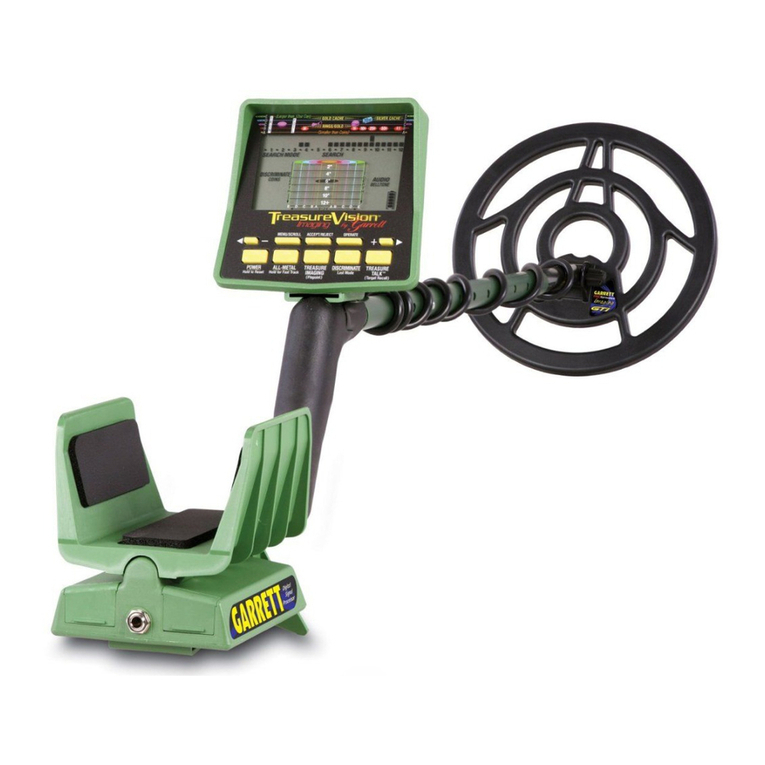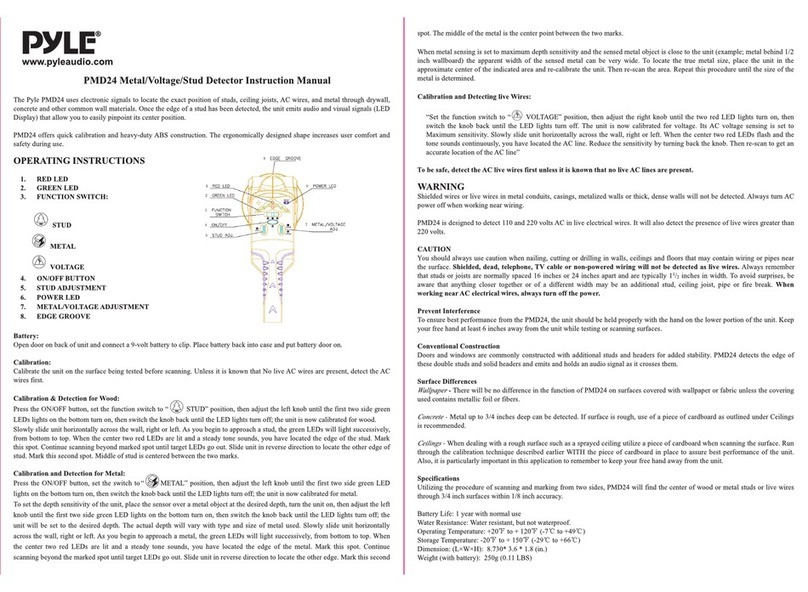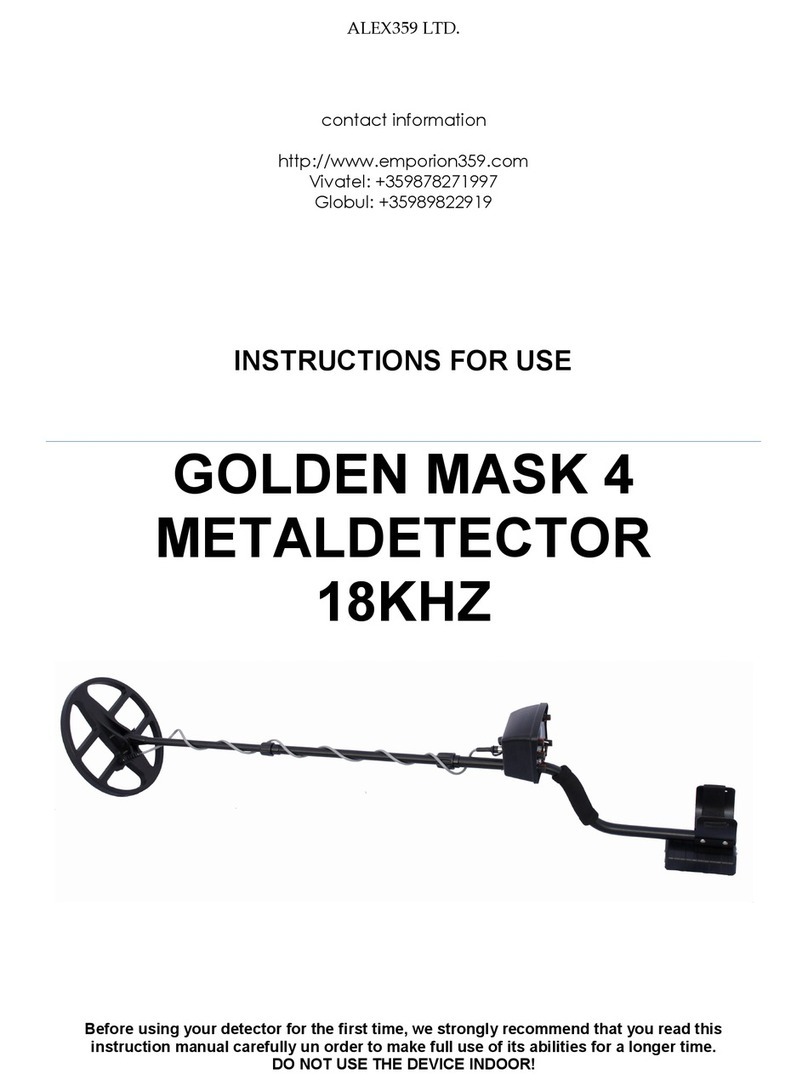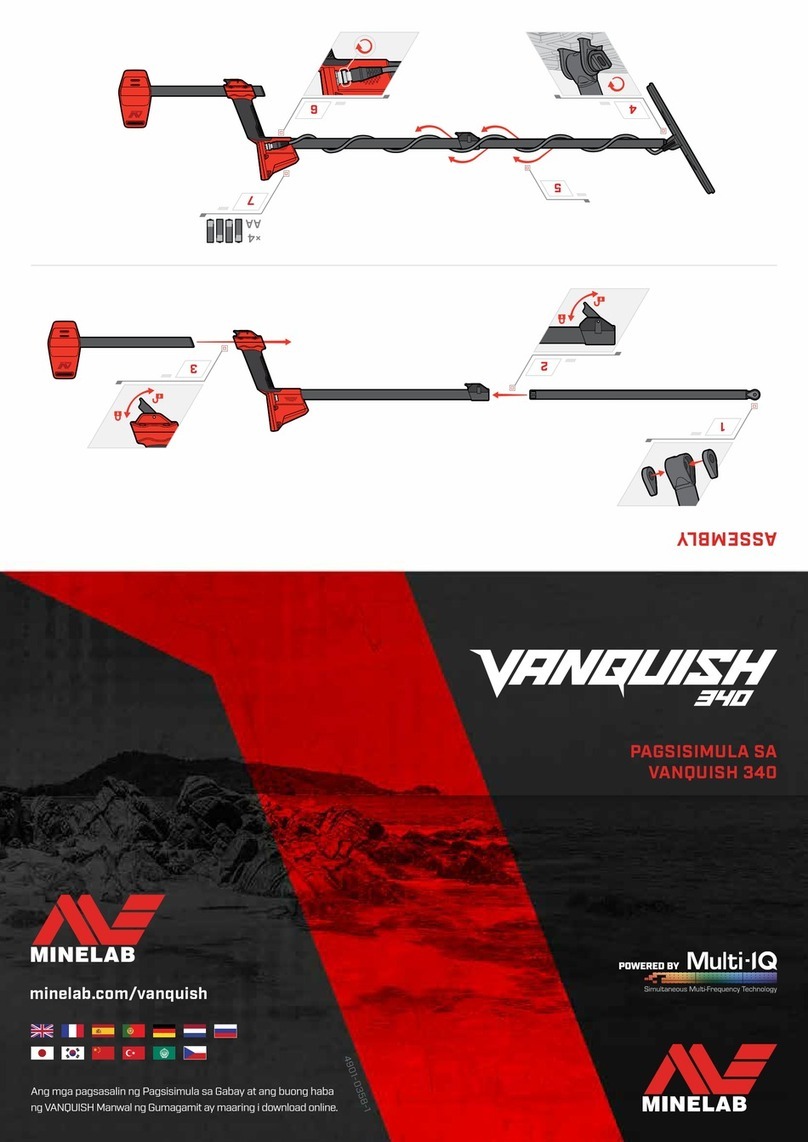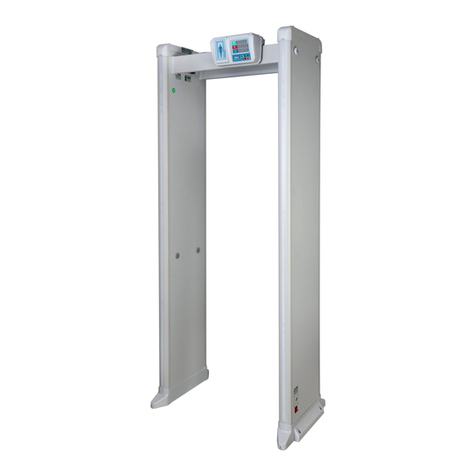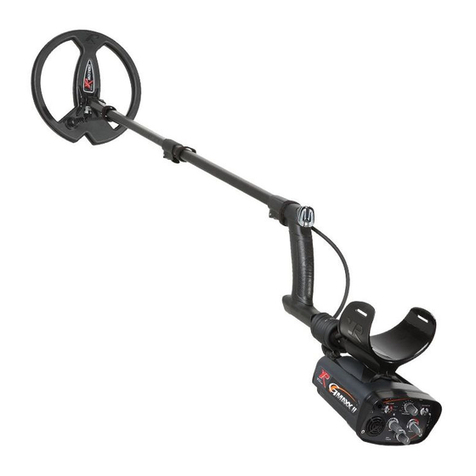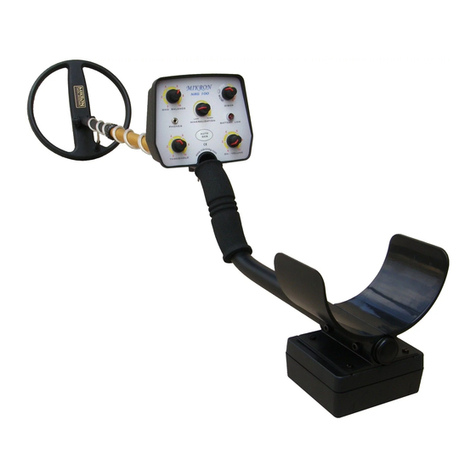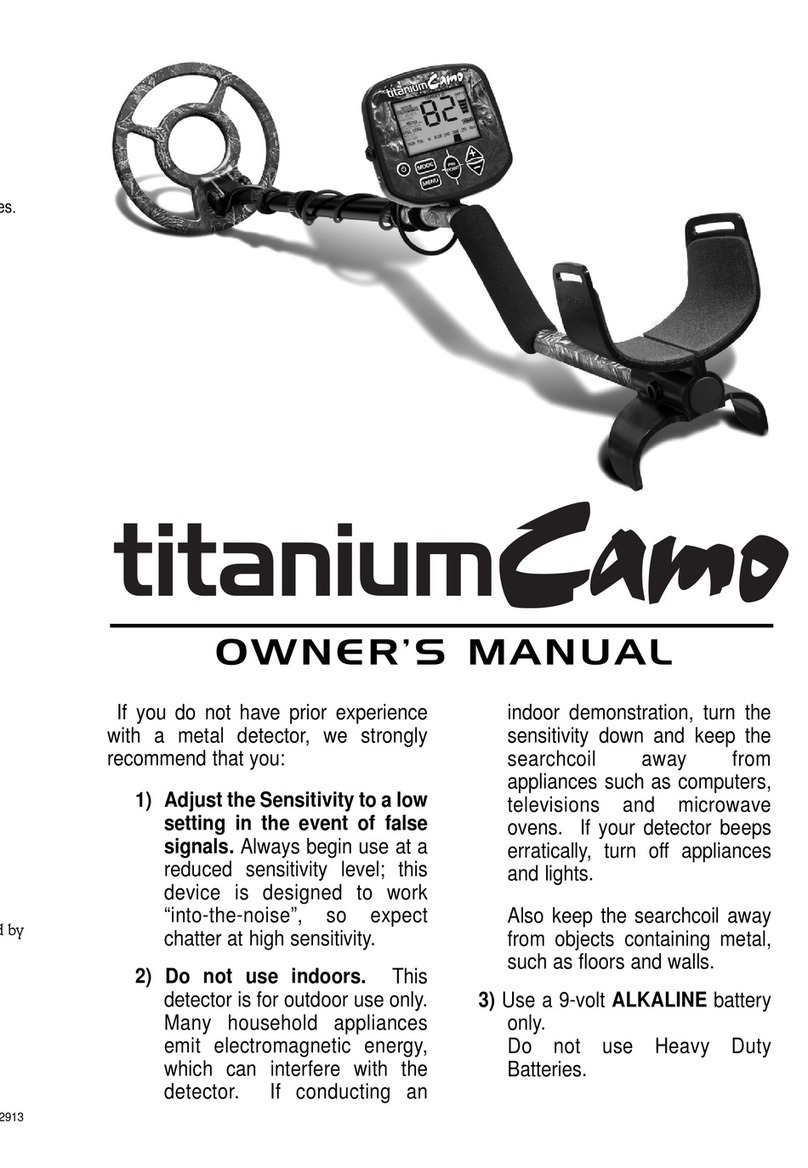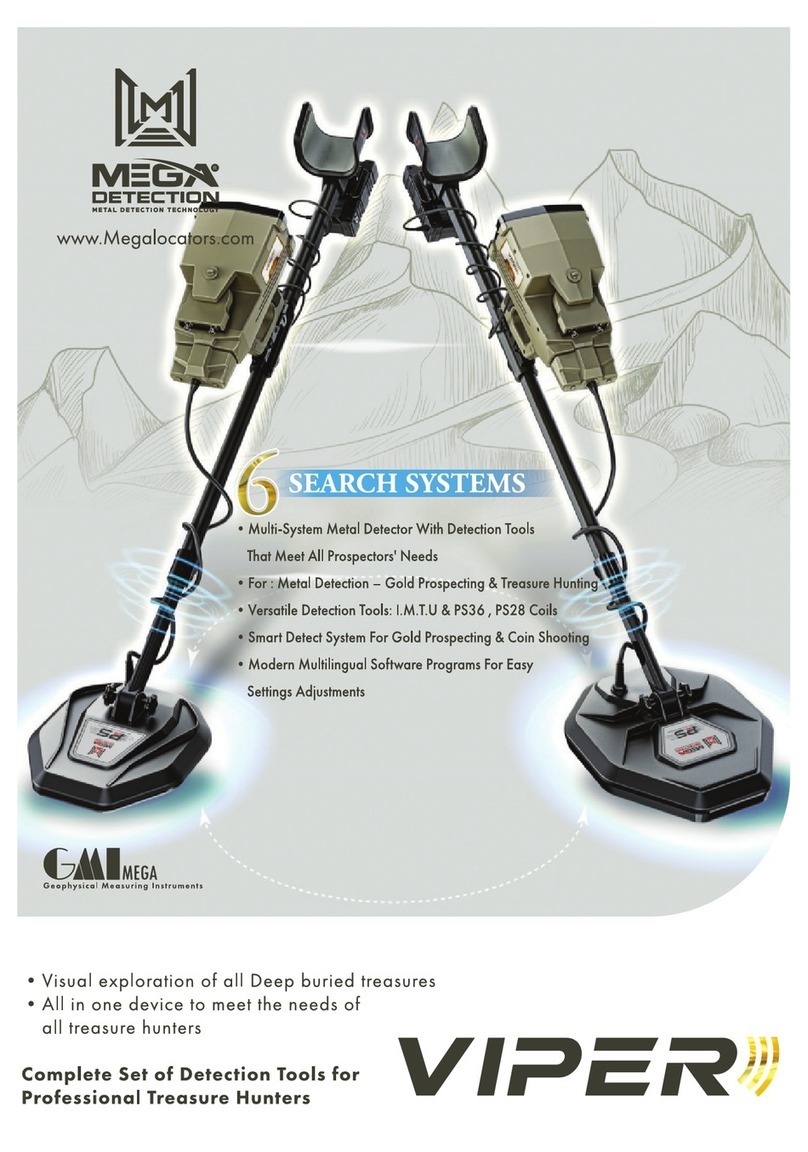Troy Custom Detectors SHADOW X3 Setup guide

Troy Custom Detectors, Inc.
13015 Harkness Drive
Dallas, Texas 75243
Tel: (972) 690-5703
Fax: (972) 644-6999
Web Site: www.troycustomdetectors.com
Troy Custom Detectors
SHADOW X3
Owner Instruction Manual
High-Performance Detecting ... Simplified!

Troy Custom Detectors Shadow X3
2
Under the copyright laws this documentation may not be cop-
ied, photocopied, reproduced, translated or reduced to any
electronic or machine-readable form, in whole or in part, without
the prior written consent of Troy Custom Detectors, Incorpo-
rated, except in the manner described in this documentation.
Troy Custom Detectors, Incorporated.
2002 All rights reserved.
Printed in the U.S.A.
Troy Custom Detectors, Inc.
13015 Harkness Drive
Dallas, Texas 75243
(972) 690-5703
Version 1.0 January 2003
43
Owner Instruction Manual

Troy Custom Detectors Shadow X3
42 3
Owner Instruction Manual
CONTENTS Page No.
Welcome...........................................................................................4
Forward.............................................................................................5
Features............................................................................................6
Assembly.......................................................................................7, 8
Controls.............................................................................................9
Battery.............................................................................................10
Quick-Set Settings...........................................................................11
Headphones....................................................................................12
Audio Sounds......................................................................13, 14, 15
Sens (Sensitivity).............................................................................16
Freq (Frequency)...........................................................................17
Disc (Discrimination).................................................................18, 19
Search Coil......................................................................................20
Target Check™.........................................................................21, 22
Pinpoint...........................................................................................23
Target Depth...................................................................................24
Target Recovery..............................................................................25
Places to Search.............................................................................26
Types of Detecting....................................................................27, 28
Responsible Detecting....................................................................29
Care & Storage...............................................................................30
Glossary............................................................31, 32, 33, 34, 35, 36
Specifications............................................................................37, 38
Warranty..........................................................................................39
Notes...............................................................................................40
A Final Message From Troy............................................................41

Troy Custom Detectors Shadow X3
4
High-Performance Detecting ... Simplified!
Team X3er’s
Your new Troy Custom Detectors Shadow X3™ metal detector is
built with the finest parts and workmanship available. It is designed
from top to bottom to provide you with many happy hours of enjoy-
ment in the most rewarding hobby I can think of – Treasure Hunting!
Ahead of you lie fascinating and exciting experiences as you step
into the past, uncovering artifacts lost by past generations or as you
take pleasure in the great outdoors with family and friends searching
for precious metals. I only wish we could share these future experi-
ences with each and every one of you.
Your Shadow X3 has the features and performance needed for you
to become successful in virtually all land hunting applications and
situations. As with any other metal detector, familiarity with this
instrument is essential in determining how successful you can be. I
recommend that you read this manual and fully understand how to
operate this detector before attempting to use it in the field. As you
become more familiar with your detector through practice, your rate
of success will increase dramatically.
The Shadow X3 is an extremely sensitive, deep-seeking metal
detector that may at times need to be operated at less than maxi-
mum settings. We feel it is important to have maximum detecting
capability available when needed, but just like a high-performance
sports car ... you can't always drive around at 200 miles-per-hour!
The Shadow X3 is a precision electronic – made in the U.S.A. –
instrument that will last for years if properly cared for. Treat it right
and it won't let you down.
Good Hunting!
Troy Galloway
41
Owner Instruction Manual
A message from ...
Troy Galloway, President of
Troy Custom Detectors, Inc.
Shadow X3’ers,
In this day and age it is not easy to start a new company with new
products and compete successfully with the larger and well-established
companies. This is the reason I want to express my sincere appreciation
to you for becoming an owner of a Shadow X3 detector.
This is currently
my lightest, most powerful, true turn-on-and-go detector.
“Customer Satisfaction” is my top personal goal and objective. It is a
simple deduction, if you are not happy with your Shadow X3 then I also
cannot be happy. As the Owner of Troy Custom Detectors, Inc. and a
fellow detectorist, I want you to contact me personally if you ever experi-
ence a problem with your Shadow X3 that is not resolved to your satis-
faction with our normal Customer Service channels. I can be reached at
1-877-437-4345 (toll free).
I wish you the best of luck with the finds you make with your new
Shadow X3 and hope to see you in the field.
Best regards,
Troy Galloway

Troy Custom Detectors Shadow X3
40
NOTES
¢¢
Date Purchased:
Purchased From:
Serial #:
NOTES
5
Owner Instruction Manual
Your Shadow X3 is a deep-seeking, extremely advanced metal
detector expressly designed to excel at coin, jewelry, relic, prospect-
ing, competition and cache searching. It is designed to have High-
performance;Extreme Comfort and effortless Ease-of-Use.
We are very happy to say that all design goals have been achieved
and are quite evident in the overall performance, versatility and
packaging of the Troy Shadow X3 metal detector.
Yes, its performance is first-rate! Its comfort has to be experienced to
be appreciated and its ease-of-use is the perfect complement to its
wide-ranging versatility.
The Shadow X3's miniature, state-of-the-art electronic design, using
ultra-miniature surface-mount electronic components, greatly contrib-
utes to a detector that is very compact, lightweight and comfortable
to use ... even for those all-day hunts.
It features simple, front-panel operation, using 'real' knobs and
switches. There are no complicated programs, layered menus to
navigate or remember, and a user can immediately tell at a glance,
exactly how the detector is tuned and operating.
Changing modes, pinpointing targets and 'fine-tuning' the X3's set-
tings and operation could not be easier! The Shadow X3 is a very
user-friendly metal detector!
Troy Custom Detectors has invested heavily in the design and
development of the Shadow X3. We utilize the best design engineers
available, incorporate leading-edge technology and make use of a
first-class production, test and service facility.
Throughout the design and development of the Shadow X3, we
gathered suggestions and comments from detectorists across the
United States. All of this 'feedback', combined with very extensive
pre-production field testing, gives you a metal detector unlike any you
have owned or used before. With Troy Custom Detectors Shadow
X3, your metal detecting experience, enjoyment and success is
about to change forever!
FORWARD
¢¢

Troy Custom Detectors Shadow X3
6
The Troy Shadow X3 is a lightweight, powerful, extremely versatile
metal detector that provides a unique combination of features, functions
and operator-control.
Some Unique Shadow X3 Features Include:
„„ Ultra-Light Weatherproof Design – 2.2 lbs with Battery
„„ Single, Drop-in, 9-Volt Battery – Up to 25-Hours operation
from a Alkaline type and 50 hours from a Lithium type battery
„„ Turn-On-and-Go Preset Operation or Full Manual Control
„„ Factory-calibrated Preset Ground Balance
„„ Tri-level Target-Check™Function for Signal Comparison
„„ VCO All-Metal or DISC-mode Pinpointing – Your Choice
„„ Deep, padded arm cup. Soft, comfortable hand grip. Built-In
detector stand
„„ Strong, rigid ABS plastic search coil and control housings
„„ O-ringed controls for stability and weather protection.
„„ Interchangeable search coils
„„ Maximized-design. Ease-of-control and operation
„„ High-sensitivity 19 kHz operation
„„ Limited Lifetime Warranty – From Fisher Research Laboratory
FEATURES
¢¢
39
Owner Instruction Manual
LIMITED LIFETIME WARRANTY
Troy Custom Detectors believes in the products we produce and
backs this belief with a limited lifetime warranty, the best in the
industry, on all of our consumer detectors. Warranty may vary out-
side of the United States. See your dealer for details.
Troy Custom Detectors does not warrant suitability to specific use
and shall in no event be liable for any direct, incidental, consequen-
tial or indirect damages.
WARNING: The opening of the sealed control housing or any
alteration and/or modification voids all warranty coverage by
Troy Custom Detectors and Fisher Research Laboratory.
Troy Custom Detectors is committed to providing you, our valued
customer, with superior service. Each and every instrument is rigidly
tested and carefully inspected during assembly and before shipment.
Should you have any questions or problems - Sales, Company Info -
contact:
Troy Custom Detectors, Inc.
13015 Harkness Drive
Dallas, Texas 75243
(972) 690-5703
Fax: 972-644-6999
Customer Service Hotline 1-877-437-4345
Web site: http://www.troycustomdetectors.com
Authorized Service Location:
FISHER RESEARCH LABORATORY
200 West Willmott Road.,
Los Banos, California 93635
Tel 209.826.3292 Fax 209-826-0416
www.fisherlab.com
email:[email protected]
for a dealer near you 1-800-M-SCOPE-1 1-800-672-6731
Troy welcomes all calls to personally assist you with any questions,
problems or tips. Please place calls between 10:00 AM and 6:00 PM
Central Standard time. Prospective Dealers Welcome!
WARRANTY
¢¢

Troy Custom Detectors Shadow X3
38
Battery Door: Weatherproof with Positive Lock Fastener
Battery Test: On-Demand with Variable Audio Tone
Control Housing: Internal RFI Shielding and Weatherproof
Pushbutton Pinpoint Switch: Weatherproof
Toggle Switches: Weatherproof With Internal 0-Ring in Actuator
Control Knobs: With O-ring & Tension Adjustable
Optimum Temperature: 20 to 110 degrees F
Optimum Humidity: 0 to 100% R. H.
Rod Design: 3-Piece with snap-button and camlock stabilizers
Arm Cup: Foam-Padded Adjustable – Forward & Backward and To Arm Size
Warranty: Limited Lifetime
SPECIFICATIONS - continued
¢¢
7
Owner Instruction Manual
Assembling your Shadow X3 metal detector is a simple and easy task
that should take only a few minutes to accomplish. – No special tools
are required.
The search coil is shipped already attached to the lower stem (pole). All
that is required to complete assembly is to attach the lower stem to the
upper S-pole/control box assembly.
Carefully unpack and save the shipping box for storage or future ship-
ment. Your box should contain:
1. SEARCH COIL - With coil-mounting hardware – bolt, nut and two
rubber friction washers - Factory assembled.
2. POLE - The pole assembly consists of a lower and upper half.
3. BATTERY - One 9-volt Alkaline type - Factory installed.
If any of these items are missing, immediately contact the Troy Author-
ized Dealer where your detector was purchased.
„ ASSEMBLY
uUnscrew the silver-metal coil connector locking collar (turn counter-
clockwise) and temporarily disconnect - by gently pulling outwards - the
coil connector from the rear of the control-box housing.
vLoosen (turn counterclockwise - as viewed from the operating posi-
tion) both plastic camlocks on the upper and lower poles.
wInsert the lower stem with attached coil into the upper pole assembly
by pressing and holding the silver snap-button. As you slide the pole into
the upper pole, guide it to drop the snap-button through the fourth
(middle position) snap-button hole.
xHold the detector as you would while using it and adjust the shaft
length to match your height and stance by pressing in on the snap-
button and moving the lower pole to the most suitable hole position for
you.
ASSEMBLY
¢¢

Troy Custom Detectors Shadow X3
8
ASSEMBLY - continued
¢¢
Slightly loosen the coil mounting wing-nut and adjust the coil angle to be
parallel to the ground while holding the detector in its operating position.
Tighten the wing-nut to lock and hold the coil position firmly in place.
Take care to not over tighten the wing-nut.
yTighten both pole camlocks by turning fully clockwise - as viewed
from the operating position.
zLeave an inch or two of slack cable, just above the search coil strain
relief bushing entry point. You will need enough slack cable to enable
the search coil to be moved throughout its entire (tilt) adjustment range.
Carefully begin to firmly wrap the search coil cable around and up the
shaft of the pole assembly leaving enough ‘free’ cable to insert the coil
connector plug into the search coil connector jack on the back side of
the control-box housing. Tighten (turn clockwise) the silver-metal con-
nector locking collar until firmly seated. DO NOT OVER-TIGHTEN!
See the ‘CARE AND STORAGE’ section of this manual for additional
information.
37
Owner Instruction Manual
These specifications are subject to change without notice
Ultra-Light Weatherproof Design: 2.2 lbs With Battery (May Vary Slightly)
Turn-On-and-Go Operation: Fixed Preset Ground Balance
Silent Search Operation: All Modes of Operation
VLF Fast Response: Both Modes of Operation
Operating Modes:
• Normal Discrimination Fixed-preset Ground Balance
• Target Check Fixed-preset Ground Balance
• VCO Pinpoint (Non Motion) Fixed-preset Ground Balance
Audio Discriminator: Full Range (All-Metal)
Ground Balance: Fixed-preset
Operating Frequency: 19 kHz
Frequency Shifter: ±170 Hz Above and Below 19 kHz
Standard Search Coil: Waterproof 7-Inch Round Open-Center Concentric
Search Coil Compatibility: 9-Inch Accessory Round Concentric Spider and
Future Troy Custom Detectors Accessory Coils
Coil Cable Length: Approximately 3 ft 6 Inches (42 Inches)
Audio Frequency: Approximately 550 Hz
Audio Output:
550 Hz tone to a sealed 3-inch Mylar-coned front-panel-mounted
speaker or weatherproof rear-mounted ¼ -inch stereo headphone jack
Headphone Compatibility: Standard ¼ -inch water-resistant stereo plug
Battery Requirement: Single 9-volt Alkaline or Lithium
Battery Life: Approximately 25 hours for Alkaline and 50 hours for Lithium
Battery Compartment: Drop-In and Weatherproof (No Wires or Connectors)
SPECIFICATIONS
¢¢

Troy Custom Detectors Shadow X3
36
Target Masking - The affect of a discriminated target near a desirable
target which prevents the desirable target from being sensed and heard.
(see recovery speed also)
Target Perception - The ability to audibly determine the exact center of
a small target prior to retrieval by listening to its audio signal. Head-
phone usage markedly increases target perception by providing a
balanced audio signal to each ear, thus making target 'centering' easier.
Threshold - The slight audio sound heard through the speaker or
headphones when operating in the threshold-dependent all-metal mode
or threshold discrimination mode. The threshold sound is set by the
threshold control and can be kept constant by using auto-tuning.
Threshold-Dependent All-Metal Mode - An operating mode that
responds to any metallic target. When adjusted properly, this mode
always has a slight background audio tone, known as audio threshold,
that 'informs' the operator that the detector is operating at its optimum
peak threshold point.
Tone - The pitch (frequency) of the audio signal heard through the
speaker or headphones when a metal target is sensed.
Tweak - A slight adjustment to a control. To fine-tune.
VCO - Voltage Controlled Oscillator. A method of audibly presenting
target information by both frequency (tone) and amplitude (volume). As
a target is approached, using VCO, the tone and volume begin to in-
crease from a soft 'growl' to a louder, higher-pitched tone as the target
center is passed directly beneath the search coil center. VCO is a
momentary operating mode to aid in pinpointing and target recovery.
VLF - Very Low Frequency. A range of electromagnetic frequencies
where ground-canceling metal detectors typically operate. This range
extends from about 1 kHz to 50 kHz with most detectors operating in the
3 kHz to 30 kHz range.
Zero Discrimination - A motion discrimination setting that is activated
by placing the DISCscrimination control at its full counterclockwise
number '1' position, thus accepting all metal targets. search coil motion
is required to detect targets.
GLOSSARY - continued
¢¢
9
Owner Instruction Manual
CONTROLS
¢¢
The Shadow X3 Control Panel

Troy Custom Detectors Shadow X3
10
Your Shadow X3 requires a single 9-volt Alkaline or Lithium battery for
its operation. It is recommended that only name-brand, high-quality
Alkaline or Lithium types be used to insure proper fit, maximum operat-
ing time and dependability. A unique 'drop-in' battery-compartment
design eliminates any possibility of fragile wire and/or battery-snap
breakage and field down time!
Battery life will vary, but you can expect about 25 hours for the Alkaline
type and 50 hours for the Lithium type of 9-volt battery.
To replace or install a battery, set the
SENS
control to the
POWER OFF
position. Unlatch the battery compartment door by pressing down and
out on the door latch. Carefully remove the old battery.
Insert a new battery with the contact end going in first, making certain to
match the battery polarity with the markings indicated.
If you are not going to be using your detector for several weeks or
longer, remove the battery. Acid damage caused by a leaking battery
can void your warranty. For best protection, remove the battery after
each detecting outing.
The Shadow X3 is equipped with an on-demand battery test circuit. The
battery should be checked after the detector has been on for a few
minutes by placing the DISC control to the BATT TEST position.
The BATT TEST produces a high-pitched tone to the speaker for a fully
charged battery, a medium tone for a half-charged battery and a low
tone for a weak battery.
The X3 never looses depth or produces weak audio until the battery
condition ‘hits’ approximately 6.0 volts – There is no need to replace the
battery until this condition occurs. Some detectors loose depth and
audio volume as the battery looses voltage ... The Shadow X3 will not!
BATTERY
¢¢
35
Owner Instruction Manual
Set Point - An electrical and/or mechanical reference or operational
point determined to be an optimum setting to achieve a particular result.
Shape Tracing - A method of audibly tracing a buried target to deter-
mine its size and shape. This is usually accomplished using the thresh-
old-dependent, non-motion, all-metal mode. The target is slowly
scanned and the length and width of the detector's audio signal is
monitored listening for the 'drop out' points. This audio 'signature' di-
rectly equates to the target's shape.
Signal Strength - The strength and volume that a target produces as it
is scanned and sensed by the search coil.
Sweep - The movement of the search coil over the ground.
Sweep Speed - The speed at which the search coil is swept back and
forth.
Target Acquisition - Troy Custom Detectors search coils are of a
unique proprietary design-configuration that enables the coil's electro-
magnetic field to cover a broad area of ground, somewhat like a wide-
scan design – but maintains the exact pinpointing ability of a concentric
design. Targets are acquired and heard more easily, even if not
scanned directly on center. This equates to more ground coverage and
total finds!
Target Check™- A unique user-selectable feature of Troy Custom
Detectors used to compare target signals against factory-calibrated
discrimination set-points to aid in identifying a target's conductivity – A
valuable 'tool' to help identify trash from treasure before retrieval.
Target Halo
- Usually associated with iron (ferrous) targets. The 'halo' is
the result of the rusting and decomposition of the target, which leaches
into the surrounding soil matrix making the target appear larger and
more conductive than it actually is. Non ferrous targets can also build up
a halo, depending on the soil conditions and length of time buried.
Any signal that 'disappears' during retrieval and no ferrous item can be
found, should be carefully investigated. It could possibly be a coin or
other desirable item that had its halo broken-up upon retrieval. Use the
ALL-METAL mode to scan the hole very thoroughly before moving on.
GLOSSARY - continued
¢¢

Troy Custom Detectors Shadow X3
34
Non-Motion
- A search mode that does not require search coil motion to
sense a target.
Null - The 'drop-out' in audio threshold or signal when the search coil is
passed across a rejected target.
Operating Frequency - The RF (radio frequency) search coil-transmit-
ted and received frequency that the metal detector is designed to oper-
ate at.
Overlap - The amount of search coil ground-sweep that overlaps the
previous sweep.
Overload - This results when a large object or too strong signal over-
loads the detector's circuitry and cannot be analyzed properly. Raising
the search coil away from the target will eliminate the overload signal
and an accurate 'reading' can then be achieved.
Pinpoint - The act of determining the exact center of a target so that it
may be quickly and easily retrieved with minimal effort and no damage.
Positive Ground - Sand or soil that contains positive, conductive salt.
Preset - A predetermined or recommended setting that is indicated on
the detector's front panel by a unique color, graphic symbol or marking.
It can also refer to an internal control or setting that is factory-adjusted to
a certain value or position.
Recovery Speed - The speed at which the detector recovers or is able
to respond to a good target immediately after it has rejected a bad
target. (see target-masking also)
Rejection - Total elimination of a particular target or range of targets.
Search Coil
- A mechanical and electrical component, consisting of wire
coils and tuned circuits that transmit and receive the R.F.electro-
magnetic signal from the metal detector, to the target and then back
again for the purpose of sensing buried metallic objects.
Sensitivity
- A term used to indicate how well a metal detector responds
to small targets. Also, a variable control to adjust the detector's re-
sponse to all targets, especially small, low-conductive ones.
GLOSSARY - continued
¢¢
11
Owner Instruction Manual
Your Troy Shadow X3 metal detector is very easy to operate!
As you become accustomed to its various features and controls, your
knowledge will improve of which features and settings perform best for
different types of detecting, search and soil conditions encountered and
locales.
To simplify getting started, you may simply want to set the DISC and
SENS controls to their black preset positions.
These are the number ‘3‘ position for the DISC control and the number
‘8‘ position for the SENS control.
Set both the FREQ and TARGET CHECK switches to their NORM
position.
Keep in mind that these are general, average settings and may not
always provide optimum results.
As your knowledge, experience and proficiency expand, you will likely
want to experiment somewhat and 'fine tune' the X3's operation to suit
your particular style of detecting and the search site’s soil and trash
conditions. Do not be afraid to experiment ... It's part of how you learn!
QUICK-SET DETECTING
¢¢

Troy Custom Detectors Shadow X3
12
Your Shadow X3 is equipped with a water-resistant rear-mounted
¼-inch (6.3mm) stereo headphone jack.
Located on the back side of the control box, the jack accepts most
stereo and mono headphones with an impedance rating of 8 ohms or
more. Upon use, the internal speaker is automatically disconnected.
The use of high-quality, high-sensitivity headphones – like the Troy-
PRO™headphones – is strongly encouraged and recommended.
Headphones block-out background noise while detecting and enable
deep, low-volume signals to be heard more easily. They also help with
'target perception', thus making pinpointing much easier.
Headphone-use increases battery life. All-in-all, headphones should
always be used while metal detecting!
To produce the strongest and best audio signal possible for deep, weak,
targets, the Shadow X3's audio circuit is designed to produce full-gain
audio. The Shadow X3 does not have an external, adjustable volume
control. Thus, it is capable of producing a very loud audio signal in
response to surface or large-mass metal targets.
To protect your hearing while using head-
phones, it is strongly recommended that you
use properly adjusted, volume-control-
equipped headphones – like the
Troy PRO
™
headphones - available soon!
Care must be taken when using head-
phones to protect your hearing from loud
and/or continual audio-tone blasts.
For best results, rotate your headphone
volume controls to their minimum, full-coun-
terclockwise position. Gradually increase
each control to a comfortable, well-balanced
listening level as you scan back and forth – a
few inches away – from a U.S. Quarter
placed directly on top of the ground. Once
adjusted, leave the volume controls set to this
optimum setting while detecting.
HEADPHONES
¢¢
33
Owner Instruction Manual
order to sense targets buried within.
Hot Ground - Severely mineralized ground that produces many false
signals as it is swept. Coal cinders and iron-laden slag soil are but two
examples of 'hot ground'.
Hot Rock - A rock or piece of mineralization that is different in its miner-
alization content than the surrounding ground matrix. Hot rocks can
produce false signals in some operating modes and no response in
others.
Interference - Usually an affect of R.F. (radio frequency) and electro-
magnetic pulse-type signals. These can be from power lines, transmit-
ters, electric fences, automobiles, other metal detectors and/or almost
any device that produces electromagnetic radiated energy. These types
of interference usually produce false, random, erratic signals that pro-
duce unexpected audio 'blips' from a metal detector.
Mineralized - Soil, sand or ground matrix that contains varying amounts
of negative iron oxide.
Mode - An operational arrangement and/or selection of specific metal
detector features and settings to match a specific type of detecting or
target acceptance or rejection.
Modulated Audio - An audio signal produced by the metal detector
(when a target is sensed) to the speaker or headphones that is very
loud for surface targets and gradually gets softer as the distance is
increased between the target and the search coil. Modulated audio is
very useful in determining a target's depth and size, based on the
strength of audio signal heard.
Motion Mode - A metal detector operating mode that requires the
search coil be kept in motion to respond to metal targets.
Neutral Ground - Ground or soil matrix that contains neither positive
nor negative mineralization.
Negative Ground - Sand or soil that contains negative iron minerals.
Non Ferrous - A metal item that does not contain iron.
GLOSSARY - continued
¢¢

Troy Custom Detectors Shadow X3
32
positively-conductive salts. These can produce positive, false, responses
to a metal detector, depending on its design and mode of operation.
De-tune - An operating method used to minimize a target's signal
(response) while operating in a non-auto-tuned all-metal or pinpoint
mode; Making the target 'appear' smaller in size and easier to find and
retrieve.
To de-tune a target, pinpoint the target's center. Hold the detector still
over that point and momentarily 'tap' , release, then hold the VCO PP
pushbutton. This may be repeated as often as needed.
Discrimination - An operating mode that enables a user to 'dial-in' the
types of targets to be discriminated or rejected by the metal detector, so
that they will not produce an audio response signal when passed over
by the search coil. The amount of discrimination is set by the Discrimina-
tion control while operating in the motion Discrimination mode.
False Signal - An erroneous signal produced by an undesirable or
discriminated target such as a large piece of iron, hot-rock or by electri-
cal pulse-type electromagnetic interference.
Ferrous - A metal item made of or primarily containing iron.
Frequency - A unit of measure of the number of times a periodic wave-
form repeats itself in a given unit of time (generally seconds) with the
result expressed in Hertz or some multiple thereof.
Frequency Shift - A selective shift of frequency above or below the
center, normal operating frequency of a metal detector for the purpose
of eliminating coincidental outside frequency-related interference.
Fringe Target - A very weak, barely discernible target very near the
point of being no longer sensed or detected. This can occur for many
reasons including depth, size, composition, mineralization, ground
moisture, coil size, detector settings, etc.
Ground Balance - A control, circuit and method of balancing-out miner-
alized ground so that it does not affect the 'pickup' of desirable targets.
Ground Matrix – The combined composition of soil, mineralization,
moisture and salts that a metal detector must radiate a signal through in
GLOSSARY - continued
¢¢
13
Owner Instruction Manual
SURFACE ITEM - is typically loud! Depending on the site being
searched, you may or may not want to retrieve these items.
In soft, loamy soil, where previous targets have been located deep, you
will most likely find loud targets to be surface trash or new coin drops.
When searching old, wooded sites or somewhat barren hillsides where
gravel and stone are in abundance, you should retrieve all targets, as
even old coins and artifacts can be found laying exposed on the surface
or only a few inches deep!
DEEP ITEM - This type of target has a smooth, consistent, weak audio
response.
If searching in the DISCrimination mode, switching to the VCO PP
(pinpoint) mode will also produce a weak, but repeatable response.
These are often the types of signals that produce the deepest, oldest
and best finds.
TRASH - Can oftentimes be recognized by its, loud, irregular or
'scratchy' audio response.
If searching an area where items are consistently located deep, you can
usually ignore the loud (usually trash) surface targets.
Using the 'shape-tracing' and 'deep item' information and techniques
presented herein can also help identify trash versus good targets.
IRON - Can often sound like a good target, but a few operating tech-
niques can be used to determine if the target is worth digging or not.
Increasing your sweep speed from slow, to moderate, to fast, will usually
cause the detector's audio response to breakup or completely disappear
if the target is made of small iron. On the other hand, desirable targets
will usually be heard – sometimes even better – with a faster sweep
speed.
Another approach to determining if a target is made of iron or not is to
sweep the target from different directions. Usually, worthwhile items will
sound the same regardless of the direction that they are swept, unless
the target is tilted or next to a trash item. Iron however, will usually
change its audio response, as it is swept from different directions. It may
AUDIO SOUNDS
¢¢

Troy Custom Detectors Shadow X3
14
sound good one way, but breakup or totally disappear when swept from
another direction.
You can also measure the target's width, or size, using the VCO PP
mode. Iron targets will often 'measure' larger (wider) than the coil's
overall diameter. Coins and other nonferrous items will usually measure
as a small, concentrated signal, that is much smaller in size than the
coil's overall width.
BAD GROUND - Is characterized by a random, intermittent, 'popping',
'static' type of audio sound. Reducing the sensitivity setting may help.
SHAPE-TRACING - Using the VCO PP mode, you can usually deter-
mine the shape of a target by slowly 'tracing it', listening for where the
audio sound drops out.
Small items, such as coins, buttons and rings will produce small, consis-
tent, 'round sounds'.
Long, narrow items, such as iron nails and wire, will produce long,
narrow signals in all-metal and will often 'double beep' audio in the
discrimination mode.
Large items will produce a signal over a large area of ground.
Audio 'shape-tracing' can be a useful tool in determining if the target is
desirable or not, but it does take some practice to master.
WHAT TO LISTEN FOR - When operating in the discrimination mode,
desirable signals generally sound smooth, consistent and repeatable
from any sweep direction.
Ferrous (iron) signals are usually random and non-repeatable, unless
the item is very large in size or heavily-rusted into its surrounding soil
matrix.
With practice, you will eventually come to recognize the 'sweet,' 'small'
sound of a good target, versus the harsh, inconsistent, often too-loud or
broad sound of a trash target.
Interpreting your X3's various audio sounds may at first seem a daunting
task (if you have not used a metal detector previously). All targets may
AUDIO SOUNDS - continued
¢¢
31
Owner Instruction Manual
10-Turn - A very precise, high-resolution electronic potentiometer
(control) that divides its total resistance over ten physical 360-degree
rotations of its control shaft. Usually used for ground balancing.
Acceptance - Any metallic target that is not eliminated (rejected) by the
discrimination control and/or Target Check and produces a signal (audio
tone) when scanned by the search coil is considered to be accepted.
Air Test
- The process of sampling a target with the search coil elevated
in the air and away from any other interfering metal target, except the
one being sampled.
Air testing is a valid and useful method to determine maximum, poten-
tial, detector depth capability, discrimination-points of various targets
and their audio characteristics. It is to be used for 'guideline' results only,
as air-test results can vary for targets buried in the actual soil matrix.
All-Metal Mode - An operating mode that responds to any metallic item
thus producing an audio tone from the detector's speaker or head-
phones.
Amplitude - The strength or 'volume' of a signal.
Auto-Tuning - An electronic automatic tuning method of keeping the
threshold signal constant and unwavering.
Auto-Tuning Speed - The speed at which the auto-tune circuit updates
or refreshes the threshold tuning to keep it at a constant audio level.
Back Reading
- A strong, reflected signal from a target that is very near
the search coil. These false target responses can be eliminated by
raising the search coil away from the offending item.
Black Sand - Sand that contains a high-percentage of magnetic nega-
tive iron oxide.
Conductivity - The property of an object that deals with how easily an
electric current can pass through it. Gold, copper and silver are highly
conductive. Iron is not. All-metal objects have conductive properties that
depend on their metal type, alloy, size, etc.
Conductive Salts - Water, moist or wet sand or soil that contain
GLOSSARY
¢¢

Troy Custom Detectors Shadow X3
30
Your Troy Shadow X3 metal detector is a high-quality, precision-engi-
neered and constructed electronic device. Properly cared for, it will
provide many years of trouble-free service.
Common sense and reasonable care are the keys to keeping your
Shadow X3 in good working order – insuring a long trouble-free life.
Avoid temperature and humidity extremes. The X3 will work well in a
range of temperatures from about 20 to 110 degrees Fahrenheit and 0
to 100% relative humidity. Do not leave or store the detector in ex-
tremely hot, cold or humid areas. Never submerge the control box in
water and always protect it from heavy rain or blowing surf spray.
When being stored, or not used for extended periods of time, remove
the battery to eliminate any possible chance of leakage damage.
A coil cover is highly recommended to protect the search coil from
abrasion and possible pinhole punctures that can eventually result in
water intrusion and destruction of the search coil. The search coil is
waterproof, but needs to be taken care of and protected.
While searching, avoid hitting the search coil against rocks, trees or
other hard surfaces. Keep your search coil slightly elevated above the
ground. Especially when searching sand, gravel or hard, rocky ground.
Periodically, wipe any accumulated dirt from the control box, knobs,
switches, shaft and search coil with a soft cloth. Also, remove the coil
cover occasionally and clean any accumulated dirt buildup, which could
affect operation.
Do not over-tighten the search coil cable connector (at the control box)
and keep the coil cord neatly wrapped and secured to the pole assem-
bly. Leave enough slack in the cable, just above where it enters the coil,
so that the coil is easily adjustable through its entire 'tilt' range without
stressing the cable or its entry point into the search coil.
Treat your Troy Shadow X3 metal detector with care and you will be
assured of many trouble-free years of operating enjoyment.
CARE AND STORAGE
¢¢
15
Owner Instruction Manual
at first sound the same to you, but you will soon learn, with practice and
use, that the X3 provides a lot of target information through the unique
sounds and audio responses of its operating modes, controls and
functions.
You will eventually come to know the 'language' of your Shadow X3, and
your success will show it!
After retrieving each target try to remember the sound that it made.
A good way to learn target sounds is to build a ‘test garden’ where you
bury known targets at various depths.
By knowing beforehand what and where the targets are, you can prac-
tice scanning and listening to them. This practice can really help you to
learn, know and understand the various sounds that your detector
makes as it scans over different types of targets at various depths.
Try to always use the same headphones too. Different phones can and
will sound different. Once you get used to a good pair of headphones,
it's difficult to change to another pair, as it will affect the sounds you are
accustomed to hearing.
Keep in mind too that all good signals will not always ‘come through’
‘crystal clear’.
Many of the extremely deep or small items will not produce loud, strong
signals. Typically, they produce ‘whispers’ and it is often this kind of
slight, but mostly repeatable signal, that indicates a worthwhile item.
Items next to rejected or trash items can produce broken, non-repeat-
able signals. Again, this is where practice comes into play and all of the
‘test garden’ time you spent learning the sounds that your Shadow X3
makes.
With continued practice and a desire to learn and improve, you will
become very familiar with your Shadow X3. It is a detector that speaks
its language through the sounds it makes. Learn them well and your
success is just about guaranteed!
AUDIO SOUNDS - continued
¢¢

Troy Custom Detectors Shadow X3
16
The SENS (Sensitivity) control is one of the most important controls on
your Shadow X3.
Its setting, to a large degree, will determine the detector's depth ability,
sensitivity to small objects, degree of smooth or erratic operation, coil
surface-area pickup (detection pattern), target acquisition, sensitivity to
outside interference and other operating parameters.
A general 'rule-of-thumb' is to set the
SENSITIVITY
control as high as
possible while maintaining smooth, stable operation.
The SENS control has a range of from '1' to '10‘, with a preset setting of
'8‘. This is the recommended, beginning setting for most types of detect-
ing. As search and site conditions warrant, the SENS control may need
to be adjusted 'up' or 'down'.
A too-high sensitivity setting can result in unstable operation, that pro-
duces false signals, 'pops' and 'static'. This can make detecting very
difficult!
Unless you are detecting over extremely 'hot', mineralized ground with
many hot-rocks, your Shadow X3 should be relatively smooth sounding
– Responding only to targets accepted by the discrimination setting or
all-metal
VCO PP
mode. If you are constantly hearing false, random and
intermittent signals, decrease the sensitivity setting. This will usually
correct the problem.
POWER OFF - This control position is used to power the detector on or
off. A slight, tactile 'click' will be felt when entering or exiting this posi-
tion. At the full counterclockwise position of the SENS control, the
detector is powered off.
SENS
¢¢
29
Owner Instruction Manual
Permission to access property, search, retrieve and keep found items
should always be obtained whenever possible. This necessary prerequi-
site will prevent any problems that may arise (if you search without
permission) and will give you complete peace-of-mind while detecting.
Some remote, wooded, abandoned or forgotten sites are nearly impossi-
ble to get prior permission to search, as the property owner is unknown
and/or difficult to locate. It is often a good idea to question local resi-
dents near the site to see if the owner can be identified and permission
obtained. Make certain that you respect all property no matter how
remote, secluded or ‘forgotten’ it may be.
Fill all holes! Never leave an unfilled hole! It is the mark of an uncaring
amateur; It does not look good and it gives all detectorists a bad name
and image.
Do No Damage!
This is just common sense! Respect all property as if it
were your own!
Leave No Trash! If you dig it, take it with you! All small, retrieved trash
items should be placed in your detecting pouch to be disposed of prop-
erly. Besides, you do not want to have to dig the same piece of trash
over and over again! Large trash items – which cannot be easily carried
– are best piled in one spot and then reburied before you leave the site.
Create a Positive Image while detecting. You may be observed directly
or indirectly. A landowner may have a good or bad experience with a
detectorist, which he then passes on to others. You never know where
the 'trail' may lead or end. Always present a good image ... it is the best
policy.
As a detectorist, you may be requested at times to search for a lost
item. Maybe a landowner needs a property marker located or perhaps
someone has lost a ring or set of keys. Perhaps the police or other
agency may need assistance in locating evidence from a crime scene.
Always, willingly lend assistance where needed. Not only will you feel
good in doing so, but it serves a very useful purpose and presents metal
detecting and detectorists in a very positive manner.
RESPONSIBLE DETECTING
¢¢

Troy Custom Detectors Shadow X3
28
COMPETITION - If you have never been to a competition treasure hunt,
you're missing out on a lot of fun!
Most hunts have thousands of silver coins, clad coins, Indian Head
cents, prize tokens and other items buried and it's usually a 30 to 60
minute 'free-for-all' to see who can find and uncover the most or best
items. Many great coins and prizes can be had at treasure hunts!
The Shadow X3 makes a perfect competition hunt detector. It is small
and lightweight. It can be swept fast and yet still responds well to tar-
gets, and the Frequency switch helps eliminate interference from other
metal detectors nearby ... its small, seven-inch coil is ideal for hunts!
Fast target pinpointing (necessary for competition hunts) can easily be
accomplished with the X3 in either the VCO PP or motion DISCrimina-
tion mode. The Target Check™feature is also very useful as it can
(depending on the prize tokens used) provide valuable information about
a target's conductivity and rejection/acceptance point.
TYPES OF DETECTING - continued
¢¢
TIP – Any signal that 'disappears' during retrieval and no
ferrous item can be found, should be carefully investigated. It
could possibly be a coin or other desirable item that had its ‘halo’
broken-up upon retrieval. Use the ALL-METAL VCO PP mode to
scan the hole very thoroughly before moving on.
Troy Galloway searches
avidly during a a recent
competition hunt.
17
Owner Instruction Manual
The three-position FREQ (Frequency) switch sets the operating fre-
quency of the Shadow X3.
It should be set to the NORM (19.0 kHz) position unless interference is
received from a nearby metal detector, such as in a competition hunt or
when searching near someone who is also using a Shadow X5 or X3.
If interference is received, the FREQ switch should be moved to the HI
(19.2 kHz) or LO (18.8 kHz) setting, whichever best eliminates or mini-
mizes the offending interference.
Certain types of ‘broadband’ pulse noise, such as electric fence, car
ignition, motor brush arcing, a distant electric storm, high-voltage or
power line arcing noise may not be eliminated by the FREQ control.
That is not its intended purpose!
The FREQquency circuit was designed to eliminate coincidental R.F.
frequency interference mainly in competition hunting or when searching
in close proximity to another Shadow X5 or X3 user or metal detector
operating at or near the 19 kHz operating frequency. Under these
conditions, it will perform as designed.
FREQ
¢¢
FREQ. SETTING FREQUENCY
HI 19.2 kHz
NORM 19.0 kHz
LO 18.8 kHz

Troy Custom Detectors Shadow X3
18
DISC
¢¢
The DISC (Discrimination) control is enabled when the detector is
operated in the DISC (Discrimination) mode.
Discrimination is used to eliminate any target that you do not want the
detector to audibly respond to. The DISC control has an adjustment
range of from 1 to 10. The lowest setting at which an object is rejected
(eliminated) is considered to be the object's discrimination point.
The DISC control is marked with a preset setting of '3'. This is the
recommended beginning setting for most types of detecting. As site and
search conditions warrant, the DISC control may need to be adjusted
'up' or 'down' to accept or eliminate specific targets.
27
Owner Instruction Manual
COIN - Most who purchase a metal detector use it to search for new
and old coins. This aspect of metal detecting – known as 'Coinshooting'
– is very popular.
To be successful at 'Coinshooting', try searching locations that have
attracted people to them over many years ... the more, the better!
Old coins are usually associated with old locations! So, you must seek-
out old sites, usually, to find old coins. Old home sites, parks, schools,
beaches, ghost towns, etc., are often the best places to search for old
coins.
RELIC - This type of detecting is most often associated with Civil War
artifacts, but any type of old, non-coin artifact is generically considered
to be a relic.
Whether it be from the Civil War, American Revolution or 20th century, a
relic can be a button, bullet, tool, buckle or any of thousands of different
items recovered while metal detecting. The varieties and possibilities are
staggering, unpredictable and endless!
As with coin hunting, the oldest and sometimes best finds come from the
oldest places.
History and research are the true 'keys' to successful relic hunting. But,
the right metal detector – such as the Shadow X3 – proper equipment,
knowledge and experience also help considerably.
BEACH -GOLD! This is the magic word for a beach hunter! Gold, for
the most part, is what they seek. Gold rings, gold chains and gold
jewelry can often be found in abundance at the right beach or swimming
location.
Most successful beach hunters dig it all. They use very little, if any
discrimination, as small gold rings, chains and jewelry 'tune out' very
easily if too much discrimination is used.
PROSPECTING - This type of detecting is usually in search of gold
nuggets in the DISC mode, using zero discrimination. The Shadow X3‘s
high operating frequency and high gain contribute to making it ‘hot’ on
gold.
TYPES OF DETECTING
¢¢

Troy Custom Detectors Shadow X3
26
Metal detecting IS NOT permitted in Federal parks and on battlefields,
historically marked lands or sites!
State, county, city or town property, parks, schools, beaches, etc. vary
with each locale. You MUST contact the appropriate office or authority
beforehand to inquire if metal detecting is permitted and what (if any)
regulations or constraints apply.
For private property, permission is usually required and it is best to have
permission in writing if possible.
Some remote, wooded, abandoned or forgotten sites are nearly impossi-
ble to obtain prior permission to search, as the property owner is un-
known and/or difficult to locate. It is often a good idea to question local
residents near the site to see if the owner can be identified and permis-
sion obtained. If not, and the property is not posted, you may want to
take your chances, but make certain to do no damage. Respect the
property no matter how remote or secluded it may be.
The 'bottom line' is: Observe all laws, whether national, state or local.
There are plenty of good places to search, but you must do some
research to find them. ‘Read-up’ on your local history. Talk to some
older residents and family members. Inquire as to where the ‘old’ places
were ... Old home sites, schools, parks, fair grounds, picnic groves,
swimming holes, lookouts, camp grounds, etc. The list is almost end-
less. It's up to you! Locate the sites and you will make the finds!
If you have a metal detecting club nearby, join it! Being with others
involved in the hobby can help immensely.
Start a library of metal detecting books and also subscribe to some
metal detecting and historical magazines.
You will amass a lot of information in doing so
and it will contribute to making you a much
better detectorist overall.
PLACES TO SEARCH
¢¢
Observe all signs ... Always!
19
Owner Instruction Manual
DISC - continued
¢¢
At a setting of ‘3‘, most small iron targets will be rejected and everything
from foil on up will be accepted – As shown in the illustration below.
BATT TEST - A battery test is performed when the DISC control is set
to the BATT TEST position. (see Battery page)
Always use the least amount of discrimination possible. High discrimina-
tion settings can eliminate many desirable targets, increase target
masking and decrease detection depth.
The illustration below shows the approximate discrimination points –
where items are rejected and/or accepted in relation to the DISCrimina-
tion control setting while operating in the DISC mode. Your settings may
vary slightly.
These are approximate settings only. You will need to determine the
exact points on your detector by sampling various targets and then
noting at what DISC control number they are rejected.

Troy Custom Detectors Shadow X3
20
SEARCH COIL¢¢
The Shadow X3 is equipped with a 7-inch, waterproof, open-center con-
centric search coil.
Troy Custom Detectors Shadow X3 search coils are completely compati-
ble and interchangeable. In fact, the X3 coils are designed to have mini-
mal effect to the detector's ground balance when changing to any size
accessory coil.
Troy Shadow X3 search coils are electrostatic shielded and 100% water-
proof. Their unique mechanical and electrical design insures a large
‘footprint’ of ground coverage, excellent depth. precise pinpointing and
super stability.
Future Shadow X3 accessory search coils will most likely be a 9-inch
elliptical widescan ‘Double D’ ; A 11-inch concentric ‘Spider’ and a 5-inch
solid concentric. Accessory coil (scuff) covers will also be available.
A 9-inch concentric ‘Spider’ coil is also available and makes for a good
‘all around’ coil for use in all types of detecting. It provides outstanding
depth and a large electromagnetic ‘footprint’ that provides full, deep,
ground coverage.
The 7-inch coil is an excellent lightweight choice for trashy sites, fast
competition hunting and quick, easy pinpointing.
For maximum depth and ground coverage select Troy’s 11-inch concen-
tric Spider search coil
Note: Check with your Troy Custom Detectors authorized dealer for
search coil availability and additional information.
25
Owner Instruction Manual
TARGET RECOVERY
¢¢
Target recovery is a very important aspect of metal detecting.
The culmination of the search ... is the retrieval of the find! –
Recovery actually begins with pinpointing!
To know precisely where to dig, to retrieve a target, you must first find
the target's exact center point.
With two types of pinpointing available – VCO and DISC mode – the
Shadow X3 makes pinpointing a quick and easy task.
Once you determine the target's center, a small digging trowel, hunting
knife or specialized metal detecting retrieval tool is all that is needed to
quickly and safely find and remove a detected target from the soil.
Careful pinpointing and retrieval will greatly minimize the chance of
accidentally scratching or damaging your find. Proper retrieval does
minimal or no damage to the soil and well-maintained areas. In fact,
99% of the time, if you know the proper way to retrieve a target, no one
can even tell that a small hole was dug!
Of course, any dug hole MUST be back-filled after the target has been
retrieved. No exceptions! Get into the habit of doing so.
In grassy areas, most detectorists cut a hinged plug for fast, easy and
neat target retrieval. Once the target is ‘pulled out’, fill the hole back in
and then step on the hinged plug a few times to firmly seat it back into
the ground.
For wooded or loose soil areas, use a trowel or long-bladed hunting
knife to displace the soil until the target is found. As above, fill the hole
back in and step on it a few times to compact it.
Make sure you take the time to learn correct pinpointing, retrieval and
‘clean up’ methods while detecting. Not only will it help you, but it will
insure that no visible ‘damage’ is done and it creates a good image for
all metal detector users.
Remember to take your trash home too for proper disposal!
Please see RESPONSIBLE DETECTING for additional information
This manual suits for next models
1
Table of contents
